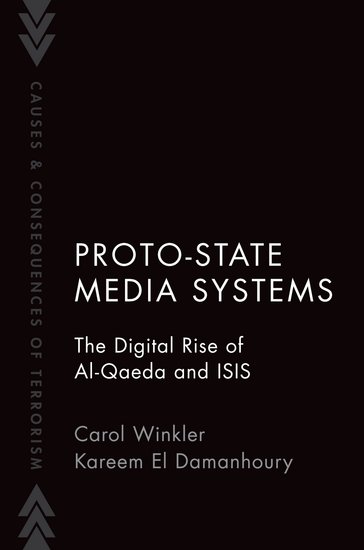Book Review by Andrew Glazzard
Terrorism is, as we know, propaganda in word and deed. Terrorists communicate symbolically (through their choice of targets, or their methods of attack) as well as directly through statements, stories and appeals. There is, therefore, no shortage of studies addressing how terrorists exploit mass media, from the made-for-television spectaculars of the 1970s to the appropriation of social media platforms in the age of ISIS.
The importance of Carol K. Winkler and Kareem El Damanhoury’s book is in reframing the media-terrorism relationship: terrorists use communication not just to intimidate and coerce through violence, but also to govern.
Studies of terrorist communication conventionally rest on assumptions that the propaganda and the violence are mutually supporting methods of mobilising support and coercing enemies so as to grant the terrorist group its political demands, which in many cases include the establishment or restoration of a state.Winkler and El Damanhoury turn this on its head by showing that, in the cases of Al-Qaeda and ISIS at least, the terrorist group already functions as a proto-state. Its communications and relationships with mass media (analogue or digital) are in the service of establishing and extending the state-like functions of governing territory and populations through military and civilian institutions.
ISIS, which in 2014 governed around 100,000 square kilometres (more than three times the size of Belgium), is tailor-made for this analysis, not least as it emphasised state-building so strongly in its media output. Al-Qaeda has also governed territory and aspires to establish a territorial caliphate, albeit with a different method and timeline from its estranged organisational cousin. But as well as challenging our received wisdom about how and why terrorist groups communicate, Winkler and El Damanhoury also interrogate theories of state media systems, such as Hallin and Manchini’s four dimensions of state media structure – media markets, political parallelism, journalistic professionalism, and the role of the state – and find them useful but deficient for militant proto-states. Unlike the conventional Westphalian state, ISIS and Al-Qaeda have little use for political pluralism, so their media structures do not need to be politically aligned and are not subject to market competition. Jihadist media outputs might have high production values, but this is to project the proto-state’s credibility rather than serve professional standards.
A Review of the Chapters
While Winkler and El Damanhoury’s theoretical approach offers much, its application to the two case studies would have benefited from further exploration and development. Drawing on constitutive communication theories which emphasise the function of discourse in forming and entrenching individual and group identity, the case study analysis focuses on identity formation through “transhistorical” and “transpatial” militancy (chapters 3 and 4), as well as the use of “material realities” (such as events and personnel) in chapter 5, and strategies for sustaining media systems in the face of internal and external pressures (chapter 6). The analysis in these chapters is sound and sometimes insightful: stories about heroes in history define norms of conduct and belief as well as helping to form identity groups, while contemporary heroes function as “transpatial vessels” who challenge existing borders and embody new geopolitical formations, which are not topographically limited (as was the case with those nationalist militants who could have defined the precise borders of Palestine, Kurdistan or Khalistan).
They also valuably investigate the use of attention-seeking events and propaganda as ways of demanding geopolitical recognition. But most of this material would not be out of place in a more conventional study of the tropes and themes of ISIS and Al-Qaeda propaganda. Analysis of how ISIS and Al-Qaeda appropriated historical events like the Battle of Badr and how contemporary fighters are lionised and military victories celebrated is not irrelevant to the book’s thesis, but this material remains within the terrorist scholar’s comfort zone, and does not approach the question of how these groups see and act like states. It would have been illuminating, perhaps, to compare the media strategies of jihadist proto-states with those of recognised but repressive states in the region, such as Saddam Hussein’s Iraq (an apposite case study given the presence of former Baathists in ISIS’s command structures) or Assad’s Syria, to explore how Al-Qaeda and ISIS media operations responded to the challenges of governing populations through fear and reward. Examining the media operations of the Taliban as it transitioned twice from insurgent force to de facto government might also have presented opportunities to deepen and enrich the analysis of how militants who aspire to govern develop their media strategies and operations. Other groups mentioned in passing, such as the FARC in Columbia, would also have provided fascinating cases that would have taken us into less familiar territory (in every sense).
A Call for Future Works
As it is, restricting case study selection to two closely linked jihadist groups limits not just the scope but also the generalisability of the book’s conclusions, so while it offers depth and richness it provides only limited evidence for its argument that proto-states require a different set of analytical tools from those used to examine media system in established states. The book’s theoretical challenge is well-delivered and persuasive. To fully realise its potential, further empirical research – of a type less familiar to those already versed in studies of jihadist propaganda – is required.
Want to submit a blog post or have a book for reviewers? Click here.
